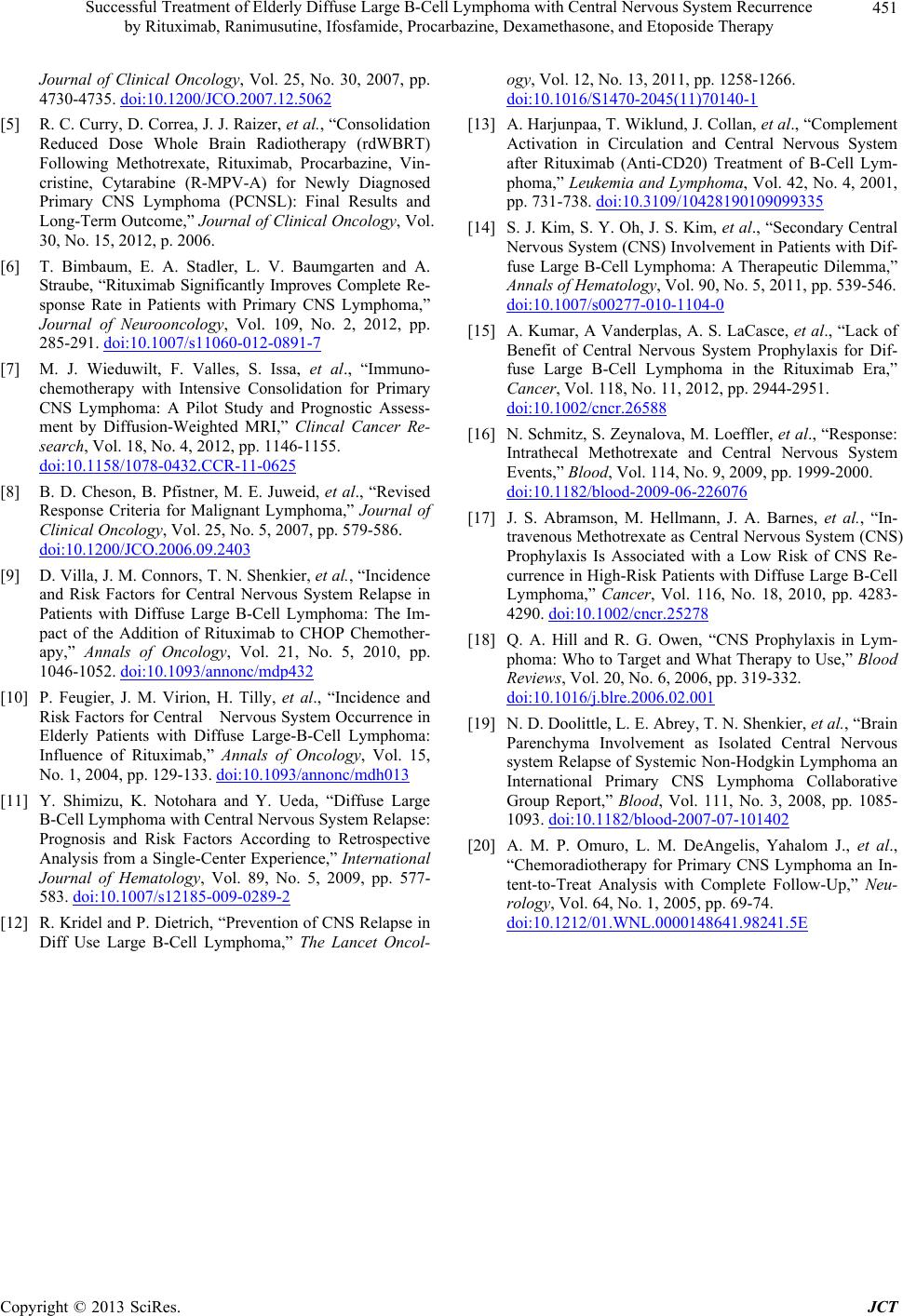
Successful Treatment of Elderly Diffuse Large B-Cell Lymphoma with Central Nervous System Recurrence
by Rituximab, Ranimusutine, Ifosfamide, Procarbazine, Dexamethasone, and Etoposide Therapy
Copyright © 2013 SciRes. JCT
451
Journal of Clinical Oncology, Vol. 25, No. 30, 2007, pp.
4730-4735. doi:10.1200/JCO.2007.12.5062
[5] R. C. Curry, D. Correa, J. J. Raizer, et al., “Consolidation
Reduced Dose Whole Brain Radiotherapy (rdWBRT)
Following Methotrexate, Rituximab, Procarbazine, Vin-
cristine, Cytarabine (R-MPV-A) for Newly Diagnosed
Primary CNS Lymphoma (PCNSL): Final Results and
Long-Term Outcome,” Journal of Clinical Oncology, Vol.
30, No. 15, 2012, p. 2006.
[6] T. Bimbaum, E. A. Stadler, L. V. Baumgarten and A.
Straube, “Rituximab Significantly Improves Complete Re-
sponse Rate in Patients with Primary CNS Lymphoma,”
Journal of Neurooncology, Vol. 109, No. 2, 2012, pp.
285-291. doi:10.1007/s11060-012-0891-7
[7] M. J. Wieduwilt, F. Valles, S. Issa, et al., “Immuno-
chemotherapy with Intensive Consolidation for Primary
CNS Lymphoma: A Pilot Study and Prognostic Assess-
ment by Diffusion-Weighted MRI,” Clincal Cancer Re-
search, Vol. 18, No. 4, 2012, pp. 1146-1155.
doi:10.1158/1078-0432.CCR-11-0625
[8] B. D. Cheson, B. Pfistner, M. E. Juweid, et al., “Revised
Response Criteria for Malignant Lymphoma,” Journal of
Clinical Oncology, Vol. 25, No. 5, 2007, pp. 579-586.
doi:10.1200/JCO.2006.09.2403
[9] D. Villa, J. M. Connors, T. N. Shenkier, et al., “Incidence
and Risk Factors for Central Nervous System Relapse in
Patients with Diffuse Large B-Cell Lymphoma: The Im-
pact of the Addition of Rituximab to CHOP Chemother-
apy,” Annals of Oncology, Vol. 21, No. 5, 2010, pp.
1046-1052. doi:10.1093/annonc/mdp432
[10] P. Feugier, J. M. Virion, H. Tilly, et al., “Incidence and
Risk Factors for Central Nervous System Occurrence in
Elderly Patients with Diffuse Large-B-Cell Lymphoma:
Influence of Rituximab,” Annals of Oncology, Vol. 15,
No. 1, 2004, pp. 129-133. doi:10.1093/annonc/mdh013
[11] Y. Shimizu, K. Notohara and Y. Ueda, “Diffuse Large
B-Cell Lymphoma with Central Nervous System Relapse:
Prognosis and Risk Factors According to Retrospective
Analysis from a Single-Center Experience,” International
Journal of Hematology, Vol. 89, No. 5, 2009, pp. 577-
583. doi:10.1007/s12185-009-0289-2
[12] R. Kridel and P. Dietrich, “Prevention of CNS Relapse in
Diff Use Large B-Cell Lymphoma,” The Lancet Oncol-
ogy, Vol. 12, No. 13, 2011, pp. 1258-1266.
doi:10.1016/S1470-2045(11)70140-1
[13] A. Harjunpaa, T. Wiklund, J. Collan, et al., “Complement
Activation in Circulation and Central Nervous System
after Rituximab (Anti-CD20) Treatment of B-Cell Lym-
phoma,” Leukemia and Lymphoma, Vol. 42, No. 4, 2001,
pp. 731-738. doi:10.3109/10428190109099335
[14] S. J. Kim, S. Y. Oh, J. S. Kim, et al., “Secondary Central
Nervous System (CNS) Involvement in Patients with Dif-
fuse Large B-Cell Lymphoma: A Therapeutic Dilemma,”
Annals of Hematology, Vol. 90, No. 5, 2011, pp. 539-546.
doi:10.1007/s00277-010-1104-0
[15] A. Kumar, A Vanderplas, A. S. LaCasce, et al., “Lack of
Benefit of Central Nervous System Prophylaxis for Dif-
fuse Large B-Cell Lymphoma in the Rituximab Era,”
Cancer, Vol. 118, No. 11, 2012, pp. 2944-2951.
doi:10.1002/cncr.26588
[16] N. Schmitz, S. Zeynalova, M. Loeffler, et al., “Response:
Intrathecal Methotrexate and Central Nervous System
Events,” Blood, Vol. 114, No. 9, 2009, pp. 1999-2000.
doi:10.1182/blood-2009-06-226076
[17] J. S. Abramson, M. Hellmann, J. A. Barnes, et al., “In-
travenous Methotrexate as Central Nervous System (CNS)
Prophylaxis Is Associated with a Low Risk of CNS Re-
currence in High-Risk Patients with Diffuse Large B-Cell
Lymphoma,” Cancer, Vol. 116, No. 18, 2010, pp. 4283-
4290. doi:10.1002/cncr.25278
[18] Q. A. Hill and R. G. Owen, “CNS Prophylaxis in Lym-
phoma: Who to Target and What Therapy to Use,” Blood
Reviews, Vol. 20, No. 6, 2006, pp. 319-332.
doi:10.1016/j.blre.2006.02.001
[19] N. D. Doolittle, L. E. Abrey, T. N. Shenkier, et al. , “Brain
Parenchyma Involvement as Isolated Central Nervous
system Relapse of Systemic Non-Hodgkin Lymphoma an
International Primary CNS Lymphoma Collaborative
Group Report,” Blood, Vol. 111, No. 3, 2008, pp. 1085-
1093. doi:10.1182/blood-2007-07-101402
[20] A. M. P. Omuro, L. M. DeAngelis, Yahalom J., et al.,
“Chemoradiotherapy for Primary CNS Lymphoma an In-
tent-to-Treat Analysis with Complete Follow-Up,” Neu-
rology, Vol. 64, No. 1, 2005, pp. 69-74.
doi:10.1212/01.WNL.0000148641.98241.5E